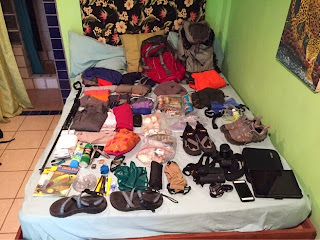Sometimes, as we reach for the 25th plate to wash, stick our head into a roasting hot metal barrel in the jungle, or wait for army ants to clear out of our cabina.....our minds go to the Talking Heads' song "Once in a Lifetime".
One stanza goes something like this:
"And you may ask yourself
What is that beautiful house?
And you may ask yourself
Where does that highway go to?
And you may ask yourself
Am I right?...Am I wrong?
And you may say to yourself
We often ask ourselves "My God, what have we done?" Perhaps the real question is how did we end up without a house, in a distant land, begging for rides from almost strangers or finding the coins to jump on a standing-room only bus to the next town or border. Our lives have become increasingly unusual by most of our friends' and families' standards. For the past five months we have been traveling Central America, mostly for our own education, but also to seek educational opportunities for a few dozen graduate students and to create connections for our university. The results of this atypical life can be hilarious at times. One recent morning that started before 6 am had us rushing from morning duties including smoking about 20 pounds of bacon in the tropical forest, (a task as fun and as hot as it sounds), to a conference call with our boss and colleagues back at Western. The conference call via wifi was briefly interrupted by loud bird calls and our mentioning a snake we spotted a few feet away. Ten minutes later, we were back into deep discussion, squatting on a wood plank bench low to the ground, when we both caught movement out of the corner of our eyes. The snake was rapidly approaching us!

For those of you familiar with snakes, you know they typically avoid people they clearly see. This one raced to us, reared up, and struck toward our feet! We scrambled up narrating the situation to our colleagues as we saw that the snake had successfully struck and killed a small rodent which had been hiding in the shade of our feet under the bench. Triumphantly, it held its kill high in the air, weaving between us toward a quieter patch of forest to enjoy its breakfast. We continued our conference call, eyeing our seat, and scanning our surroundings.

For those of you familiar with snakes, you know they typically avoid people they clearly see. This one raced to us, reared up, and struck toward our feet! We scrambled up narrating the situation to our colleagues as we saw that the snake had successfully struck and killed a small rodent which had been hiding in the shade of our feet under the bench. Triumphantly, it held its kill high in the air, weaving between us toward a quieter patch of forest to enjoy its breakfast. We continued our conference call, eyeing our seat, and scanning our surroundings.
That day was far from over before we retired to our simple cabina of four screened walls with no water, electricity or bathroom to distract us from the cacophony of forest sounds and the rush of water in the river below. We were still to have an afternoon full of meeting guests and serving drinks to an eclectic group of people including those from Ireland, France, Costa Rica, New York City, and a three time Olympian medalist from the USA. After dinner, we both had emails and manuscripts to work on while the Internet was available.
While our friends often express envy at the varied and adventurous Facebook postings we submit, we know that many, especially those who best understand the details of our days, think we are absolutely crazy. Yet, for us, the Talking Heads' title best describes how we did get here. We all have one life to live or give. Each strike of midnight brings us 86,400 seconds closer to the new day. We get to use that time only once....once in a lifetime. For us, we want to experience life in other cultures and places while helping to create a more sustainable planet and just world. We want to celebrate that life and explore diversity on the planet, our species' own as well as its other inhabitants. So we find ourselves in some pretty unusual places, seeing incredible things, facing physical discomfort and mental joy, while still trying to give time and effort to people and ideas that inspire us. We really understand that each moment is occurring "once in a lifetime" however short or long that life might be. We have come to believe that personal growth is made more challenging when we are static in our lives and daily activities, so we choose to live the unexpected life that saying "yes" more than "no" has brought us. Ours might be a rather extreme way of feeling the vibrancy of change. You do not have to leave your country and sell all of your possessions to have a more dynamic life. But each of us may need to question whether what has become routine is also satisfying. Did we spend each of today's 86,400 seconds in living fully, working toward our values, sharing our gifts and passions, doing a small kindness or selfless act? There is comfort in routine, but also danger in comfort.
Posted at Golfito, Costa Rica. Images are of Sally and our jungle smoker, our snake bench, and our simple cabina.

















